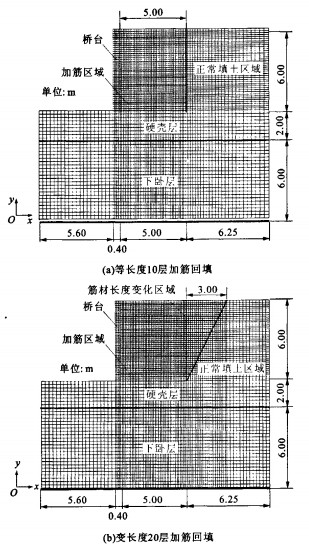Influence factor analysis of deformation behaviors for reinforced backfills behind abutment
-
摘要: 为了揭示通过加筋回填减小路桥过渡段差异沉降的力学机理, 参照桥台后加筋回填离心模型试验原型尺寸, 应用ABAQUS有限元方法建立了桥台后加筋回填平面应变数值分析模型, 通过不同加筋设计参数(加筋间距、加筋长度和筋材刚度)以及回填材料强度与地基刚度的影响因素分析, 研究了桥台后加筋回填变形性状。研究结果表明: 减小土工格栅加筋间距, 增加土工格栅弹性模量、回填材料内摩擦角以及地基刚度, 采用倒三角形变长度加筋布设, 皆可有效减小桥台后回填体表面沉降; 地基刚度特性对加筋回填变形行为的影响取决于地基与加筋回填体的相互作用特性。Abstract: In order to analyze the mechanics mechanism of reducing differential settlement at the transition section between abutment and embankment by means of reinforced backfills, the field sizes of centrifugal modeling tests were referenced, a plane-strain numerical analysis model of reinforced backfills behind abutment was established by ABAQUS finite element method, the influence factors of different reinforced design parameters such as spaces, lengths and rigidities of geogrids, strength of backfill material and stiffness of subsoil were analyzed, and the deformation behaviors of reinforced backfills behind abutment were studied. Analysis result indicates that the surface settlement of backfills behind abutment can be reduced effectively by reducing the spaces of geogrids, or increasing the elastic moduluses of geogrids, the inner friction angles of backfill material and stiffness of subsoil, or adopting the inverse-triangle variable-lengths reinforced layout of geogrids; however, the influence of subsoil stiffness on the deformation behaviors of reinforced backfills depends on the interaction characters between subsoil and reinforced backfills.
-
表 1 Clay Plasticity模型参数
Table 1. Parameters of Clay Plasticity model
材料类型 c′/kPa φ′/(°) κ υ λ M α0 β K ecs k/(m·d-1) 硬塑粘土 22.4 31.6 0.03 0.30 0.18 1.1 0 1 1 3.14 2.64×10-5 表 2 Drucker-Prager模型参数
Table 2. Parameters of Drucker-Prager model
材料类型 c′/kPa φ′/(°) E/kPa υ β′ K ψ k/(m·d-1) 粉质粘土 36.7 38.3 12 500 0.32 44.3 1 44.3 2.493×10-4 表 3 Drucker-Prager模型的硬化参数
Table 3. Hardening parameters of Drucker-Prager model
粉质粘土 σ1-σ3/kPa 64.1 175.8 252.1 342.2 436.7 εp 0.000 0.015 0.026 0.043 0.058 表 4 Duncan-Chang模型参数
Table 4. Parameters of Duncan-Chang model
材料类型 c′/kPa φ′/(°) kd nd Rf kur G F D k/(m·d-1) 风积砂 5.4 33.6 246.7 0.42 0.86 531.3 0.34 0.07 2.14 0.363 表 5 不同粘性土Clay Plasticity模型参数
Table 5. Parameters of Clay Plasticity model for different clayey soils
粘土 λ κ M ecs 软塑粘土 0.51 0.11 0.90 5.12 可塑粘土 0.36 0.07 1.00 4.23 硬塑粘土 0.18 0.03 1.10 3.14 表 6 路桥过渡段差异沉降
Table 6. Differential settlements at transition section
加筋间距/m 加筋层数 等长度加筋 变长度加筋 表面沉降/m 表面沉降/m 无筋 0 -3.41×10-2 -3.41×10-2 1.2 5 -3.11×10-2 -3.04×10-2 0.6 10 -2.63×10-2 -2.56×10-2 0.3 20 -2.22×10-2 -2.13×10-2 表 7 摩擦角不同时回填体变形
Table 7. Deformations of backfills in different friction angles

表 8 筋材弹性模量不同时回填体表面变形
Table 8. Deformations at top of backfills in different elastic moduluses of reinforcement
弹性模量Eg/GPa 表面沉降/m 格栅拉应变 2.38×10-1 -3.42×10-2 4.66×10-2 5.95×10-1 -3.27×10-2 3.60×10-2 2.38×100 -2.76×10-2 2.02×10-2 5.95×100 -2.63×10-2 1.08×10-2 2.38×101 -2.35×10-2 4.11×10-3 表 9 沉降比较
Table 9. Settlement comparison
m 表面沉降 回填竣工 工后10 a 硬塑粘土 可塑粘土 软塑粘土 硬塑粘土 可塑粘土 软塑粘土 最小值 -0.002 -0.006 -0.008 -0.021 -0.032 -0.049 最大值 -0.014 -0.018 -0.021 -0.057 -0.135 -0.196 -
[1] Monley G J, Wu J T H. Tensile reinforcement effects on bridge approach settlement[J]. Journal of Geotechnical Engineering, ASCE, 1993, 119(4): 749-763. doi: 10.1061/(ASCE)0733-9410(1993)119:4(749) [2] 周志刚, 郑健龙, 宋蔚涛. 土工格栅加筋柔性桥台的机理分析[J]. 中国公路学报, 2000, 13(1): 18-21. doi: 10.3321/j.issn:1001-7372.2000.01.005Zhou Zhi-gang, Zheng Jian-long, Song Wei-tao. Analysis of mechanism of flexible abut ment reinforced by geogrids[J]. China Journal of Highway and Transport, 2000, 13(1): 18-21. (in Chinese) doi: 10.3321/j.issn:1001-7372.2000.01.005 [3] Hel wany S M B, Wu J T H, Froessl B. GRS bridge abutmentsan effective means to alleviating bridge approach settlement[J]. Geotextiles and Geomembranes, 2003, 21(3): 177-196. doi: 10.1016/S0266-1144(03)00004-9 [4] Lee K Z Z, Wu J T H. Asynthesis of case histories on GRS bridge-supporting structures with flexible facing[J]. Geotex-tiles and Geomembranes, 2004, 22(4): 181-204. doi: 10.1016/j.geotexmem.2004.03.002 [5] Long J H, Olson S M, Stark T D, et al. Differential movement at embankment/bridge structure interface in Illinois[R]. Washington DC: Transportation Research Board National Research Council, 1998. [6] Wahls H E. NCHRP synthesis of highway practice159: design and construction of bridge approaches[R]. Washington DC: Transportation Research Board National Research Council, 1990. [7] 徐光明, 蔡正银, 刘守华. 公路三背回填离心模型试验研究[R]. 南京: 南京水利科学研究院, 2004. [8] Han J, Gabr M A. Numerical analysis of geosynthetic-rein-forced and pile-supported earth platforms over soft soil[J]. Journal of Geotechnical and Geoenvironment Engineering, ASCE, 2002, 128(5): 44-53. [9] 陈仁朋, 徐正中, 陈云敏. 桩承式加筋路堤关键问题研究[J]. 中国公路学报, 2007, 20(2): 7-12. https://www.cnki.com.cn/Article/CJFDTOTAL-ZGGL200702001.htmChen Ren-peng, Xu Zheng-zhong, Chen Yun-min. Research on key problems of pile-supportedreinforced embankment[J]. China Journal of Highway and Transport, 2007, 20(2): 7-12. (in Chinese) https://www.cnki.com.cn/Article/CJFDTOTAL-ZGGL200702001.htm [10] Pan J L, Selby A R. Si mulation of dynamic compaction of loose granular soils[J]. Advances in Engineering Software, 2002, 33(7): 631-640. [11] Yang Z. Strength and deformation characteristic of reinforced sand[D]. Los Angeles: University of California, 1972. [12] Alfaro MC, Hayashi S, Miura N, et al. Deformation of rein-forced soil wall-embankment systemon soft clay foundation[J]. Soils and Foundations, 1997, 37(4): 33-46. -





 下载:
下载:








